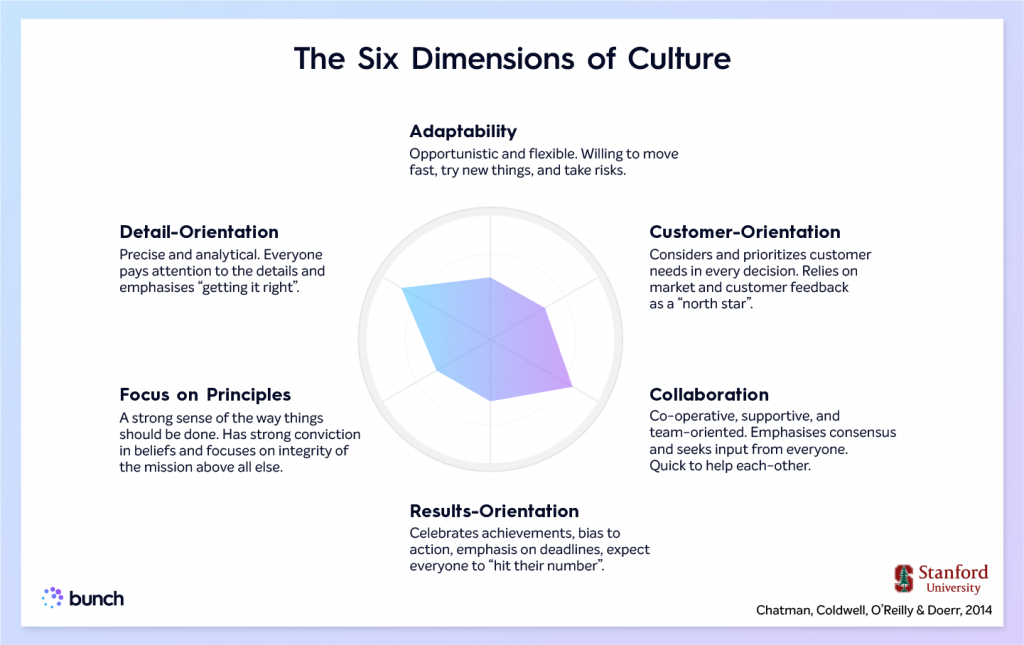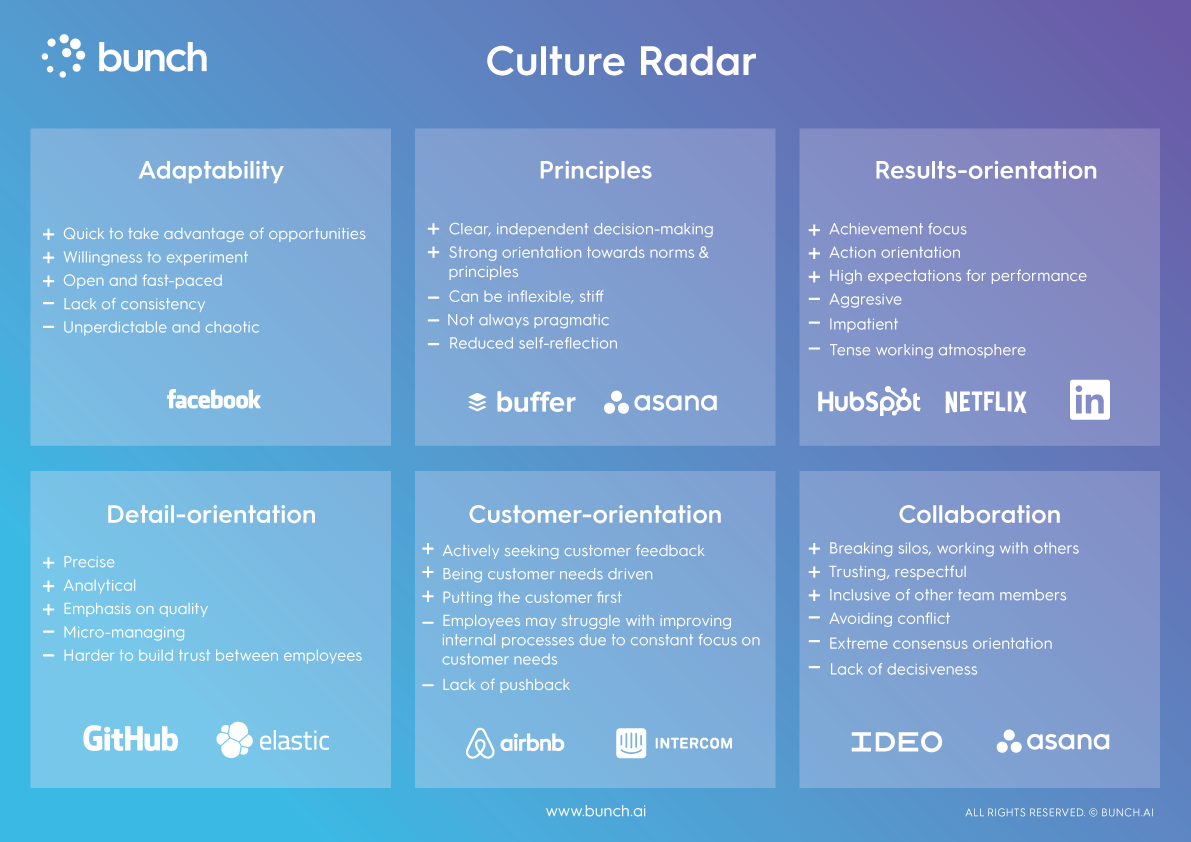Introduction
Culture is one of the most powerful and mysterious elements of a successful company. Everyone knows it’s important, but not many people can define it. Somehow, culture can feel like everything and nothing at the same time.
But as leaders, you can’t afford to leave culture up to chance. As you’ll see in this guide, there is a way to be strategic about culture, and research from Stanford has shown that companies with a strong culture generate up to 5X more revenue. A Glassdoor study has also shown that 94% of job candidates are likely to apply at companies that actively manage culture, and employees are 3X less likely to leave a company with a strong culture.
In this guide, our aim is to give leaders everything you need in one place – from the necessary academic research to the tools, and initiatives you’ll need to get started with any strategic culture initiative at your company.
Here’s a quick roadmap in case you’d like to jump around:
- Introduction
- What is culture, really?
- What kinds of culture are there?
- What does “good” culture look like?
- What impact does culture have on the business?
- How to design the ideal culture for your company
- Getting buy-in from key stakeholders
- How to measure culture
- How to influence or change company culture
- Conclusion
What is culture, really?
Far too often, company culture gets confused with concepts like happiness and engagement. The thing is, culture isn’t only about how your team feels, it’s also about how they behave, and the social norms that drive behavior.
A Scientific Definition of Culture
Professor Charles O’Reilly – an organizational behavior expert at Stanford and one of the world’s leading researchers on culture – defines culture as “a system of shared values defining what is important, and norms, defining appropriate attitudes and behaviors”.
Or, put simply, culture is “the behavior you reward and punish.”
Those rewards and punishments don’t need to be formal or explicit – in fact, culture exists largely under the surface. As Professor Edgar Schein at MIT put it, “culture is the deepest, and often unconscious part of group dynamics. This is what it makes it so hard to grasp & understand. At the same time, once culture develops it covers every function of the team. Imagine a tree growing and spreading its roots deeper and deeper in the ground.”

Jump into the Leadership Coach to get more fresh tips on culture now!
Company culture in practice: The way we do things around here
While we could nerd out for days on the academic research around culture (see our Culture Wisdom library on Github), it’s important to be practical in the way you communicate the idea of culture to your team. So how does one of today’s top business leaders describe company culture?
Brian Chesky, CEO of Airbnb, describes it as:
“a thousand things, a thousand times. It’s living the core values when you hire; when you write an email; when you are working on a project; when you are walking in the hall. We have the power, by living the values, to build the culture. We also have the power, by breaking the values, to f*ck up the culture. Each one of us has this opportunity, this burden.”

What kinds of culture are there?
Every company has a unique culture! However, there are company culture archetypes that you can observe – 6 of them, in fact.
Why 6? Professor O’Reilly and his team have found in their research that there are 6 key dimensions of culture to consider: adaptability, collaboration, customer-orientation, results-orientation, detail-orientation, and focus on principles.

This “6 dimensions” model has been proven effective in describing the differences in company performance, and pretty much any characteristic of company culture can be mapped to one (or more) of the dimensions, which makes it a great tool for describing and comparing different cultures. Here are some examples of the six different dimensions and companies that clearly prioritize each of them. We call this the Culture Radar:

What does “good” culture look like?
The ideal culture for one company might be completely different from the ideal culture at a different company. What really matters is alignment. If everyone at a company shares the same cultural norms (for example, everyone clearly prioritizes collaboration), we describe that as strong culture, which typically leads to better performance. When companies lack this alignment, culture is diffused, which typically leads to worse performance (more on that later!). That’s why the goal isn’t to simultaneously maximize all of the cultural dimensions at your company, but rather to create alignment on which ones are most important.
Leaders are using idle moments to level-up their leadership skills. Are you? Look no further – The Bunch AI Leadership Coach is here!
For example, here’s a representation of the company culture at Netflix. Notice that Netflix clearly prioritizes 2 dimensions: results-orientation, and customer focus.

Netflix’s culture seems to work well for them – not because results-orientation or customer focus are universally more important than collaboration or focus on principles. Rather, the important thing is that: people are highly aligned around what’s really important for Netflix to succeed as a company.

What impact does company culture have on business outcomes?
Culture is often thought about as an employee experience or branding tool. It is, but it’s much, much more. Culture has been proven to impact the most critical areas of your business.
Research by Professor Charles O’Reilly’s team at Stanford has established a link between culture and:
- Net income growth
- Revenue growth
- Market-to-Book Value (for public companies)
- Employee ratings
- Analyst recommendations to buy stock
Here at Bunch, we’ve been able to measure and observe concrete relationships between cultural characteristics of companies and:
- Valuations of private companies
- Stock prices
- Total investment attracted
A Glassdoor study showed that culture did in fact influence:
- Talent attraction
- Talent retention
The Bunch AI Leadership Coach contains more of Professor Charles O’Reilly’s insight – for you to power-up your learning journey.
Put simply, culture is a fundamental component of business success. To quote Louis Gerstner Jr (former CEO of IBM):
Until I came to IBM, I probably would have told you that culture was just one among several important elements in any organization’s makeup and success — along with vision, strategy, marketing, financials, and the like… I came to see, in my time at IBM, that culture isn’t just one aspect of the game, it is the game. In the end, an organization is nothing more than the collective capacity of its people to create value.

How to design the ideal culture for your company
While we’ve already seen that aligning the entire company around certain cultural norms is important for driving performance, how do you know which dimensions to prioritize? This isn’t a question that a leader can answer by themselves, nor is it something that can be decided by a simple survey: there needs to be a structured, strategic approach to do it right.
It starts with a simple question: why do our customers choose us? This can be your north star in designing the right culture for your company.
Example: A Swiss Watchmaker
Imagine you run a company that makes watches and competes based on meticulously perfect quality of engineering. If you fail to deliver this, your company will go bankrupt. What behaviors are needed to ensure perfect quality?
It’s easy to think of a few:
- Don’t make mistakes
- Have an eye for detail
- Create nothing but perfection
These all map to the cultural dimension of “Detail Orientation” in the Culture Radar, so it’s clear that success as a business depends on aligning the team around detail orientation.
Example: A Local Restaurant
Now imagine you run a small independent restaurant known for great service. The business can only remain successful as long as certain behaviors are reinforced amongst the staff. The whole team needs to:
- Aim to delight customers
- Always listen to the customer attentively
- Being friendly and speaking with respect
The Bunch AI Leadership Coach can help you with challenges like culture and much more, all under 2-mins a day.
The Data-Driven Way
If you’re already measuring your current culture using Real-Time Analytics, you can take a more data-driven approach to define and “sense check” your ideal culture. To do this, try correlating your different cultural KPIs against your most important business metrics. Which ones seem to drive product output, sales, profit, and shareholder value? This way you’ve got an ever clearer roadmap towards creating a truly high-performance organization.
Getting buy-in from key stakeholders
If your executive team has only defined values
Company values are notoriously tricky to work with.
- They lack clear prioritization
- Individual values in the list may contradict or compete with each other
- They’re designed to “sound good” (especially to prospective hires) rather than to provide behavioral guidance
These values are great for inspiration and employer branding, but if you want to strategically leverage culture for competitive advantage, having a values list is not enough. We recommend mapping your core values to translate them into a more objective, comparable format.
Ask yourself: do our values align strongly around 1-2 or the six dimensions of culture? Or are you left with a little bit of everything? Take your results and present them back to the leaders that defined the values and point out any inherent contradictions in the values.
If you’ve defined the values or inferred them via a survey
It’s common to use surveys to gather employees’ thoughts on company values. It’s democratic, fair, and collaborative. But the problem is that what you end up with is a laundry-list of loosely connected (at best) or completely contradictory (at worst) ideals that are based mainly on employees’ personal feelings about their work environment.
Values defined this way lack any connection to company objectives. When this happens, behavior inevitably deviates from the values because they aren’t aligned with incentives or realities of the business. This is what leads to values being “just a poster on the wall”, which then can negatively impact morale and employee engagement.
How to measure company culture
In this guide, we’ve tackled many of the challenges leaders face around defining, describing, and designing their company culture. But how can you be sure that any of this work is actually paying off? If you go through the hard work of defining your ideal company culture, how do you know where you stand against your goals? Luckily, culture can be measured. In this section, we’ll look at a way to do this.
The Bunch AI Leadership Coach is here – with features like calendar integration to put you back in control of your work-week!
A good way to measure company culture: Survey-Based Assessment
Remember the six dimensions of culture? You can actually survey employees about their work-related priorities to create a culture snapshot.
Pros of Survey-based Assessment:
- It’s a great way to engage the whole team in the culture design process
- You can find out what your starting point really is.
- You can show employees something interesting about themselves.
- It can also be used to assess applicants as well.
Cons of Survey-based Assessment:
- Surveys can become a bottleneck as you wait for responses,
- It’s unlikely that people will want to re-take the same survey on a regular basis, so it’s not ideal if you want to see how your culture changes over time.
How to influence or change company culture
If you’ve defined the culture you want to have and identified a gap by measuring your current culture – it’s time to get to work on affecting cultural change. The good news is that culture absolutely can be influenced! Let’s quickly look at a few examples.
Hiring: every single addition to the company has the potential to influence the culture in some way because everyone has a different mindset and working style. For fast-growing companies, being intentional about who you hire can drastically improve your chances of creating a strong (i.e. highly aligned) culture.
Incentives: earlier, we defined culture as the behavior that is rewarded and punished in your company. This system of reward and punishment can be explicit but are often implicit.
It’s all in the details here. For example, if you want to become more customer-focused as a company, think about how you can reward people for exhibiting this behavior and punish behavior that is contrary to the goal of customer focus. It’s not necessarily about compensation or perks. Ask yourself questions like:
- How can we ensure that people are praised and respected when they behave in a customer-focused way?
- How can you ensure that people’s ideas are heard if they behave in a customer-focused way?
- How can we change our decision-making processes to prioritize customer-focused perspectives?
Leading by Example: Rank and file employees will take behavioral cues from their managers, who in turn are taking behavioral cues from top leadership at the company. So if you want to create cultural change, you need to make sure that leaders very publicly exhibit the cultural characteristics that you want to re-enforce.
Take 2-mins out each day & learn in your own way with The Bunch AI Leadership Coach
Conclusion
Culture management is a big undertaking, but hopefully, this guide has empowered and inspired you to create a truly special culture at your company that drives measurable, meaningful business results.
If you have any other questions that weren’t answered in this guide, or if you’d like to contribute to it, please do get in touch.
Pro tip: you can use the Bunch assessment tool to measure the 6 dimensions in your company and apply it to your hiring process.
First published: June 3, 2019
Updated: July 5, 2020





